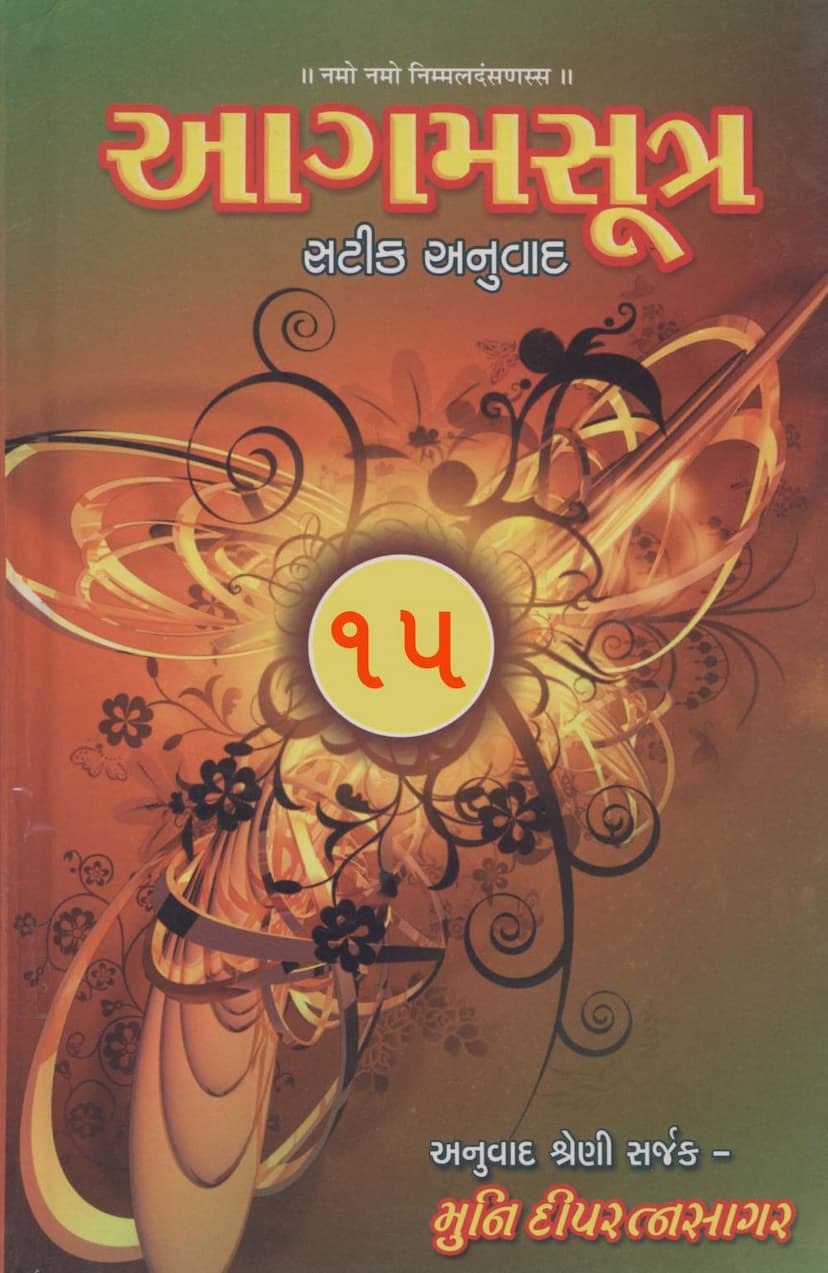Agam 07 Upasakadasha Sutra Satik Gujarati Anuvad
Added to library: September 1, 2025

Summary
This document is a section from a Gujarati commentary and translation of Jain Agamas, specifically focusing on Agam 07, the Upasakadasha Sutra (Book 15 of the Agam Sutra Satik Gujarati Anuvad series), compiled and translated by Muni Dipparatnasagar.
Here's a breakdown of the content:
Overall Context:
- Agam Sutra Satik Anuvad Series: This publication is part of a larger series aiming to provide a detailed, annotated, and translated commentary of the Jain Agamas in Gujarati. This particular volume, Bhag-15, covers Agamas 7 through 10.
- The Agamas Covered: The specific Agamas included in this volume are:
- Agam 7: Upasakadasha (Upaasakadashaa)
- Agam 8: Antakrutadasha (Antakrutadashaa)
- Agam 9: Anuttaropapatikadasha (Anuttaropapaatikaadashaa)
- Agam 10: Prashnavyakaran (Prashnavyakaran)
- The Translator/Author: Muni Dipparatnasagar is credited as the creator of this translation series.
- Sponsorship and Gratitude: The initial pages express deep gratitude to various Acharyas (spiritual leaders) and Jain sanghs (communities) who supported the publication financially, highlighting the collaborative effort involved in such scholarly works.
Content of the Upasakadasha Sutra (Agam 7):
The bulk of the provided text is the detailed commentary and translation of the Upasakadasha Sutra, specifically focusing on the first ten of its ten lessons (adhyayan). The summary of the content is as follows:
- Introduction to Upasakadasha: It is identified as the 7th Anga Sutra and its primary purpose is to explain the practices and conduct of lay disciples (upasakas). The text consists of ten lessons (adhyayan).
- Key Figures: The sutra primarily narrates the stories and teachings related to ten prominent lay disciples, including Anand, Kamdev, Chullashatak, Suradev, Kundkolik, Sadalputra, Mahashatak, Nandinipita, and Shulipita.
- Narrative Style: The text follows a narrative structure, often starting with the setting, the presence of Lord Mahavir, and then detailing the conversion and practices of the lay disciple. The commentary provides detailed explanations of the scriptural terms and concepts.
- The Role of Celestial Beings: A recurring theme is the testing of the lay disciples' devotion and adherence to their vows by celestial beings (devas) in various forms (like powerful demons or terrifying creatures). These tests are designed to challenge their faith and resolve.
- Detailed Account of Anand's Story (Lessons 1-19): The text provides an extensive narrative of Anand's journey. It describes his wealth, his conversion by Lord Mahavir, his acceptance of the twelve vows (five anuvratas and seven shikshavratas), and his adherence to these vows even when faced with severe tests from a celestial being.
- The Tests: The celestial being attempts to make Anand break his vows by showing him terrifying visions, threatening his family, and even inflicting physical pain. Anand's unwavering devotion and steadfastness in his vows are highlighted.
- Avadhijnana: Anand develops Avadhijnana (clairvoyance) and uses it to understand the future destinies of himself and the celestial being.
- Spiritual Progression: Anand progresses through eleven stages of lay discipleship (upasaka pratimā) and eventually attains a celestial life, followed by liberation (moksha).
- Detailed Account of Kamdev's Story (Lessons 20-23): Similar to Anand, Kamdev also faces intense tests from a celestial being, which he overcomes with his unwavering faith. His story emphasizes the power of adhering to vows and the spiritual benefits derived from it.
- Detailed Account of Chullipita's Story (Lessons 30-31): Chullipita faces tests involving his sons and his wife. His unwavering adherence to his vows despite the threats is described.
- Detailed Account of Suradev's Story (Lesson 33): Suradev's story also follows the pattern of facing celestial tests and maintaining his vows.
- Detailed Account of Chullashatak's Story (Lessons 34-36): Chullashatak faces tests related to his wealth and his family, demonstrating his strong resolve.
- Detailed Account of Kundkolik's Story (Lessons 37-38): Kundkolik's story involves a debate with a celestial being regarding the philosophies of Goshalak Mankhaliputra and Lord Mahavir, where Kundkolik firmly defends the teachings of Lord Mahavir.
- Detailed Account of Sadalputra's Story (Lessons 41-45): Sadalputra, an Ajivika follower, is converted to Jainism after a celestial being attempts to dissuade him and then a debate with Goshalak Mankhaliputra is presented. His story highlights the importance of understanding the correct path through reasoning and divine guidance.
- Detailed Account of Mahashatak's Story (Lessons 48-55): Mahashatak's story focuses on his wealthy lifestyle and his wife Revati's corrupt practices and temptations. Mahashatak, through his spiritual insight (Avadhijnana), foresees Revati's negative future. His unwavering adherence to his vows, even when threatened by Revati and tested by celestial beings, is emphasized. He also undergoes introspection and accepts penance for any perceived shortcomings in his conduct.
- Nandiniipita and Shalipita's Stories (Lessons 9 & 10): These stories, though briefer in the provided text, follow a similar pattern of conversion, adherence to vows, and eventual celestial life and liberation.
- Summary of the Ten Disciples: The text concludes with a summary of the cities where these disciples resided, their wives' names, the nature of the tests they faced (celestial beings, threats, etc.), their spiritual achievements (Avadhijnana, progress through pratimas), their celestial abodes, lifespan in celestial realms, and their ultimate destination (liberation in Mahavideh Kshetra).
- Commentary Style: The commentary is detailed, explaining the meaning of Sanskrit and Prakrit terms, elaborating on the narratives, and providing scriptural context. It also addresses potential nuances and interpretations of the Agamas.
Significance of the Publication:
This publication by Muni Dipparatnasagar aims to make the profound teachings of the Jain Agamas accessible to a wider audience through detailed Gujarati translations and commentaries, aiding in the study and understanding of Jain philosophy and practice.